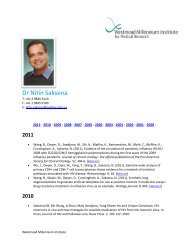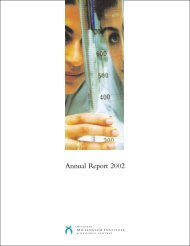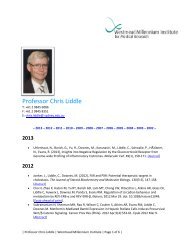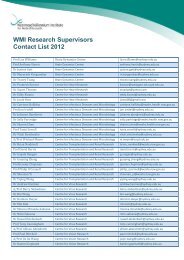Annual Report 2005 - Westmead Millennium Institute
Annual Report 2005 - Westmead Millennium Institute
Annual Report 2005 - Westmead Millennium Institute
Create successful ePaper yourself
Turn your PDF publications into a flip-book with our unique Google optimized e-Paper software.
NHMRC Centre of Clinical ResearchExcellence to improve outcomes inimmuno-suppressed haematology patientsThis prestigious 5-year grant was awarded to CIDM in collaborationwith the Haematology Department of <strong>Westmead</strong> Hospital, theNational Centre for Immunisation Research and Surveillance andresearch groups from the Universities of Sydney, New South Walesand Western Sydney. In the first year projects in prevention,diagnostics and ethical issues have been initiated, and five PhDstudents will be in place in 2006. Involving infectious diseases,haematology and ethics research, this centre aims are to improveoutcomes in immuno-suppressed haematology patients andprovide multidisciplinary research training in these areas.Centre for Virus ResearchHerpes simplex virus immunologyHerpes simplex virus (HSV) infection causing primarily cold soreand genital herpes are widespread in the Australian community,with an estimated 60-80% of adults infected with HSV-1 and 10-20% infected with HSV-2. Our group focuses on two main areas:examining the interaction of HSV and specialized immune cellssuch as dendritic cells (DC) and T cells and determining proteintargets for T cells directed against virus-infected cells. In the pastyear, we have extended our efforts in mapping out the mechanismsof HSV interference with DC, the key cell type responsible foralerting the immune system to act against the impending infection.In addition, we have been defining peptide antigens for CD4 T cellswhich have a pivotal role in HSV infection, aiming to improvepresent genital herpes vaccine candidates.Herpes simplex protein interactionThe work of this group involves elucidating the way in which herpessimplex virus assembles and moves within human nerve cells.Understanding such biological processes will allow development ofnew antiviral drugs as well as a novel viral gene therapy vector fortreatment of various neurological disorders. This group haspublished in the Journal of Biological Chemistry an article definingone possible way in which the virus moves along human nervecells. This movement depends on an interaction between a herpesviral protein VP26 and a cellular molecular motor dynein. This nowpaves the way for development of a minimal gene delivery vectorbased on the herpes viral protein VP26.HIV protein functions and interactionsThe primary goal of this group is to understand the function ofseveral HIV proteins on a molecular level, with the long term aim ofidentifying novel antiviral therapeutics. Research projects includethe elucidation of nuclear import of the HIV pre-integration complex(PIC) in collaboration with Prof David Jans at Monash University,understanding the role and function of Vpr isolated from AIDSpatients and in AIDS pathogenesis, investigation of the role of thecytoplasmic tail of the HIV glycoprotein 41, and determining the roleof methylation in HIV replication in collaboration with Dr. DavidHarrich at the Queensland <strong>Institute</strong> of Medical Research. During<strong>2005</strong>, members of this group attended several national meetingsand presented virology lectures at the University of Sydney. GroupLeader, Dr Sabine Piller, was invited to be the guest editor for aspecial issue of Current Drug Targets to be published in 2006.HIV molecular pathogenesisThis group aims to understand the very early interactions of the HIVvirus with host cells of the body, predominantly human dendritic cells(DCs). These are likely to be one of the first cells to come intocontact with HIV within the genital tract. In <strong>2005</strong>, this grouppublished the importance of the C type lectin receptors (CLRs), afamily of receptors found on the surface of the DCs that HIV uses tobind to and gain entry into the cell. They also developed a modelcell which mimics Langerhan cells in the skin and vaginal mucosacreating a very useful tool for future studies. Additionally researchersdescribed both infection rates within these cell populations andexamined the kinetics of virus degradation and dissemination.As a result of this research this group is targeting the CLRs on thevarious DC populations to develop novel strategies to interfere withthis mechanism using either soluble receptors as decoys binding tothe virus and/or by direct antagonism of the HIV binding receptorsusing small molecules. Initial studies indicate that if we can preventinfection, we can reduce or even prevent viral trafficking at a veryearly stage of infection. In parallel this group continues to search forother novel HIV binding receptors as potential drug targets andmaintain research examining global gene changes that HIV induceson the host cell using DNA microarray technology. Such studies giveinsights as to how HIV infection subverts the host cell and impairsthe function of the immune system.Retroviral geneticsThe Retroviral Genetics Laboratory is working on several key areasof HIV pathogenesis and diagnostics. Firstly, they are focussing onmechanisms of HIV disease progression and factors influencing thenatural control of HIV in a subset of HIV-infected individuals whosurvive for several years without antiretroviral treatment. The maingoal is to identify the innate immune factors conferring advantage tohost survival and also to define how some of the innate factors,such as CD8 antiviral factors, deteriorate during treatment and itsimplications in anti-HIV treatment. Secondly, this group is studyinghow HIV-1 strains interact with each other to generate additive andsynergistic effects and form fitter HIV variants. These studies mayexplain how recombination in HIV strains provides advantage infavour of virulence, transmission and efficient dispersal. Thirdly, theyare characterizing molecular traits of viruses from the brain of HIVinfectedindividuals with and without dementia. Identification of thesetraits may define neurotropism of HIV, which plays a significant rolein HIV dementia. The lab is also actively engaged in studying anddeveloping diagnostic tools for the detection of viruses such asSARS, avian influenza and HIV, using new technologies.










